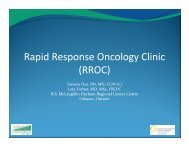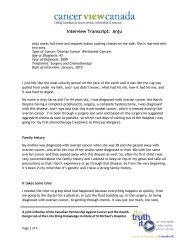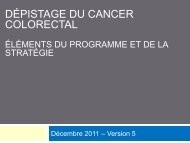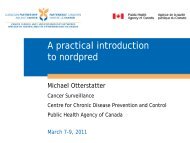A Guide to Implementing Best Practices in Person ... - cancerview.ca
A Guide to Implementing Best Practices in Person ... - cancerview.ca
A Guide to Implementing Best Practices in Person ... - cancerview.ca
You also want an ePaper? Increase the reach of your titles
YUMPU automatically turns print PDFs into web optimized ePapers that Google loves.
Navigation: A <strong>Guide</strong> <strong>to</strong> <strong>Implement<strong>in</strong>g</strong> <strong>Person</strong>-Centred Care September 2012Appendix H: Professional Navigation Conceptual FrameworkRepr<strong>in</strong>ted from <strong>Guide</strong> <strong>to</strong> Navigation, Cancer Journey Action Group (2010)Dimension Concepts Process/Functions OutcomesInformation cont<strong>in</strong>uity • Hav<strong>in</strong>g access <strong>to</strong>, and understand, high level of <strong>in</strong>formationUse of <strong>in</strong>formation, diseaseon the <strong>ca</strong>ncer patients and their <strong>ca</strong>reor person focused, <strong>to</strong> • Provid<strong>in</strong>g timely and tailored <strong>in</strong>formation and advicemake current <strong>ca</strong>re appropriate<strong>to</strong> the <strong>in</strong>terdiscipl<strong>in</strong>ary team and <strong>ca</strong>ncer patientsfor each <strong>in</strong>dividual. (patient centered <strong>in</strong>formation)Information is relevant <strong>to</strong> • Work<strong>in</strong>g closely with the <strong>in</strong>terdiscipl<strong>in</strong>ary team <strong>to</strong>l<strong>in</strong>k <strong>ca</strong>re from one providerimprove cont<strong>in</strong>uity of the <strong>in</strong>formation and knowledge<strong>to</strong> another and from of family/patients’ needs and changesone health<strong>ca</strong>re event <strong>to</strong> • Us<strong>in</strong>g communi<strong>ca</strong>tion <strong>to</strong>ols and strategies <strong>to</strong> <strong>in</strong>creaseanother.cont<strong>in</strong>uity of <strong>in</strong>formation(Haggerty et al., 2003)FACILITATINGCont<strong>in</strong>uity of <strong>ca</strong>re(experience of <strong>ca</strong>re as coherent and connected)(Organizational functions of the role)(Dimension health-system-oriented)Management cont<strong>in</strong>uityA consistent and coherentapproach <strong>to</strong> the managemen<strong>to</strong>f <strong>ca</strong>ncer that isresponsive <strong>to</strong> a patient’schang<strong>in</strong>g needs. Provid<strong>in</strong>ga sense of predictabilityand security <strong>in</strong> future<strong>ca</strong>re for both patients andproviders.(Haggerty et al., 2003)Relational cont<strong>in</strong>uityOngo<strong>in</strong>g therapeutic relationshipbetween a patientand one provider.Bridges past <strong>to</strong> current<strong>ca</strong>re. Provides a l<strong>in</strong>k <strong>to</strong>future <strong>ca</strong>re.(Haggerty et al., 2003)• Conduct<strong>in</strong>g comprehensive screen<strong>in</strong>g and needs assessment(<strong>in</strong>itial and ongo<strong>in</strong>g)• Match<strong>in</strong>g unmet needs with services, resources availableand support systems with<strong>in</strong> the <strong>ca</strong>ncer <strong>ca</strong>re organizationand the community• Identify<strong>in</strong>g lack of resources, f<strong>in</strong>d<strong>in</strong>g temporary solutionsand report<strong>in</strong>g the system gaps• Mapp<strong>in</strong>g cont<strong>in</strong>uum of <strong>ca</strong>re; expla<strong>in</strong><strong>in</strong>g <strong>ca</strong>re plan;m<strong>in</strong>imiz<strong>in</strong>g uncerta<strong>in</strong>ty (patient orientation); decreas<strong>in</strong>gbarriers <strong>to</strong> <strong>ca</strong>ncer <strong>ca</strong>re adherence• Referr<strong>in</strong>g and communi<strong>ca</strong>t<strong>in</strong>g with hospital andcommunity teams• Do<strong>in</strong>g prompt liaison• Facilitat<strong>in</strong>g coord<strong>in</strong>ation and organization of medi<strong>ca</strong>l/psychosocial<strong>ca</strong>re (us<strong>in</strong>g <strong>ca</strong>re pathways)• Contribut<strong>in</strong>g <strong>to</strong> the elaboration and appli<strong>ca</strong>tion ofthe <strong>in</strong>terdiscipl<strong>in</strong>ary <strong>ca</strong>re plan• Facilitat<strong>in</strong>g <strong>in</strong>terprofessional collaboration (hospitaland community sett<strong>in</strong>gs)• Ma<strong>in</strong>ta<strong>in</strong><strong>in</strong>g an ongo<strong>in</strong>g relationship• Be<strong>in</strong>g easily accessible through the <strong>ca</strong>ncer cont<strong>in</strong>uum• Mapp<strong>in</strong>g on the <strong>ca</strong>ncer trajec<strong>to</strong>ry how the professionalnaviga<strong>to</strong>r is <strong>in</strong>volved and until when• Be<strong>in</strong>g part of an oncology team• Be<strong>in</strong>g trusted by health providers and team members• Effectiveness <strong>in</strong> which coherent <strong>in</strong>formation is transferredand unders<strong>to</strong>od (<strong>in</strong>formation on medi<strong>ca</strong>l condition, patient’spreferences, values, and context):– among providers (e.g., SECON)– between <strong>in</strong>stitution (discharge plans, transfer of discharge<strong>in</strong>formation, referral data <strong>in</strong>ven<strong>to</strong>ry)– between primary and specialty <strong>ca</strong>re (referral documents)(e.g., PCAT)– from patient perception(e.g., PCCQ; Experienced cont<strong>in</strong>uity) Accumulated knowledge: patients <strong>ca</strong>n be asked if they knowtheir providers at earlier steps of the <strong>ca</strong>re trajec<strong>to</strong>ry; howwell they know their providers, or providers <strong>ca</strong>n be askedhow well they know their patient Satisfaction about <strong>in</strong>formation exchange <strong>in</strong> the team(e.g., EORTC-SAT32)• Coherent and timely coord<strong>in</strong>ation of services (shared <strong>ca</strong>replan+ facilitate access <strong>to</strong> a broad range of services) Longitud<strong>in</strong>al follow-up- completion rates of recommendedtreatment for <strong>ca</strong>ncer specific diseases or for "gaps" <strong>in</strong> <strong>ca</strong>refor chronic diseases (especially <strong>in</strong> transition) Perception of cont<strong>in</strong>uity of <strong>ca</strong>re (e.g., PCCQ; Experiencecont<strong>in</strong>uity)• Participation of patient <strong>in</strong> <strong>ca</strong>re (flexibility <strong>in</strong> adapt<strong>in</strong>g <strong>ca</strong>re<strong>to</strong> <strong>in</strong>dividual’s needs and circumstances) Consistency <strong>in</strong> <strong>ca</strong>re: adherence <strong>to</strong> <strong>ca</strong>ncer <strong>ca</strong>re. Applied fromprimary <strong>ca</strong>re, a measure of compliance <strong>in</strong> preventive <strong>ca</strong>refor <strong>ca</strong>ncer survivors Satisfaction with coord<strong>in</strong>ation of <strong>ca</strong>re (EORTC-SAT32) Delays/wait<strong>in</strong>g time Symp<strong>to</strong>ms relapse; worsen<strong>in</strong>g conditions Hospitalizations; emergency visits• Effective professional naviga<strong>to</strong>r / patient communi<strong>ca</strong>tion(bridges not only past <strong>to</strong> current <strong>ca</strong>re ; a l<strong>in</strong>k <strong>to</strong> future <strong>ca</strong>re) Extent <strong>to</strong> which the same provider sees the patient <strong>in</strong> differentsett<strong>in</strong>gs Strength of patient-provider affiliation (e.g., PCAT; satisfactionwith providers)81













